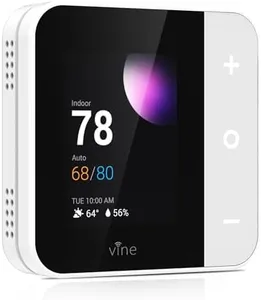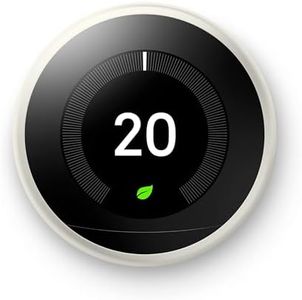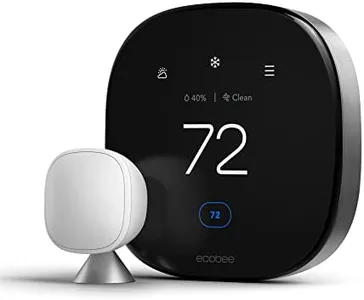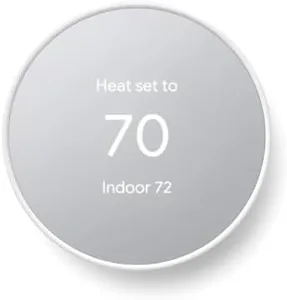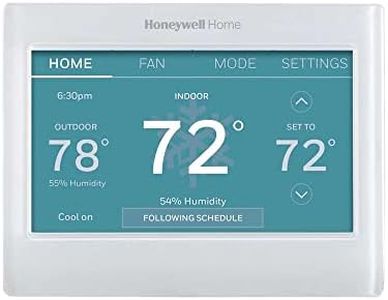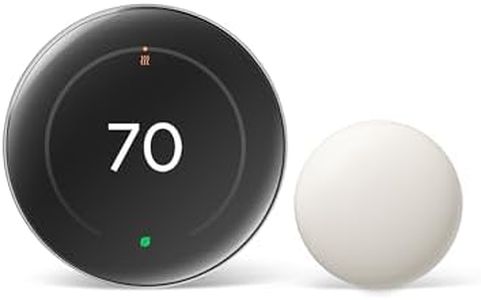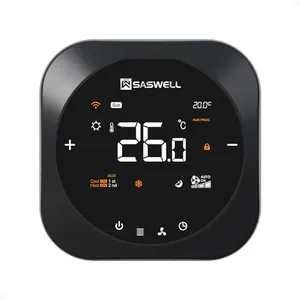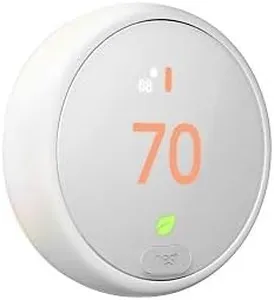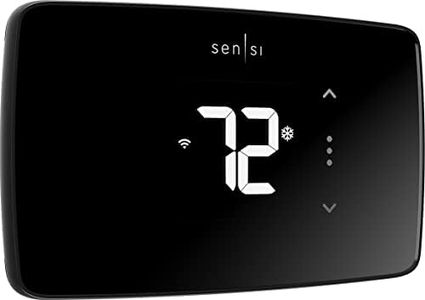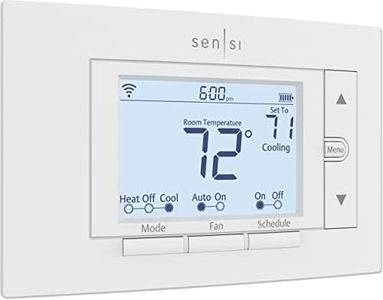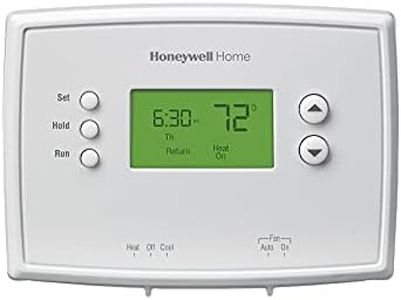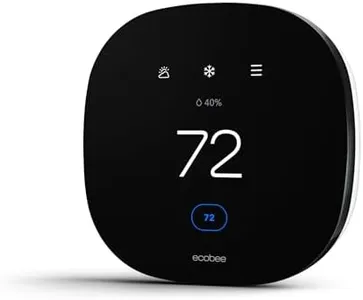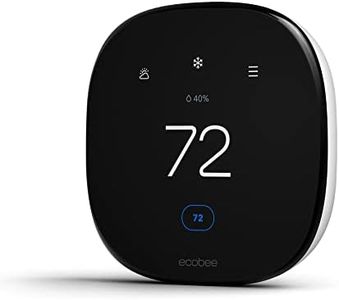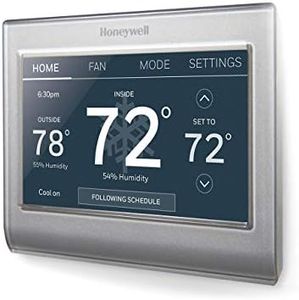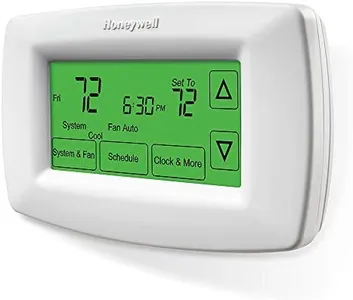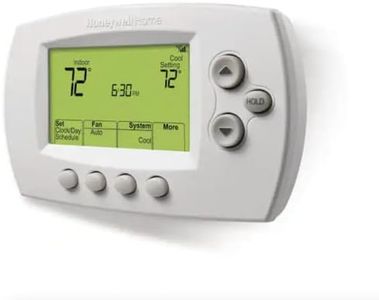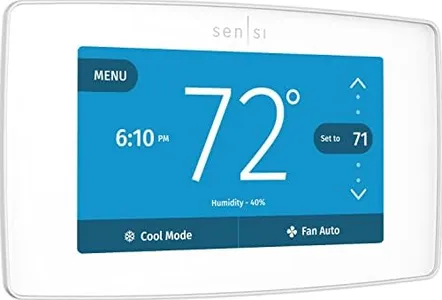10 Best Programmable Thermostats 2025 in the United States
Our technology thoroughly searches through the online shopping world, reviewing hundreds of sites. We then process and analyze this information, updating in real-time to bring you the latest top-rated products. This way, you always get the best and most current options available.

Our Top Picks
Winner
Google Nest Learning Thermostat - 3rd Gen (2015) - Programmable Smart Thermostat for Home - Works with Alexa - White
Most important from
39121 reviews
The Google Nest Learning Thermostat (3rd Gen) is a standout option for those seeking a programmable thermostat that seamlessly fits into a smart home environment. One of its main strengths is its ability to learn your daily schedule and temperature preferences, allowing it to adjust itself automatically for optimal comfort and energy savings. The Home/Away Assist feature ensures that the thermostat lowers energy usage when you're not home, helping you save on bills without sacrificing comfort.
The user interface is sleek and easy to navigate, featuring a high-resolution display that shows essential information like the temperature and time. It also boasts excellent connectivity options, being compatible with Wi-Fi and various smart home systems, including Google Assistant and Amazon Alexa. This means you can conveniently control your home's temperature remotely via your phone or through voice commands.
Energy-saving features such as Energy History and the Nest Leaf indicator promote more responsible energy usage, showing you how much energy you consume and encouraging choices that reduce waste. The compatibility with 95% of heating and cooling systems makes it versatile for many households, and installation is relatively straightforward, typically taking around 30 minutes.
Some users may find the initial cost a bit high compared to traditional thermostats. Additionally, while it’s designed for easy installation, those unfamiliar with thermostats might still find it a bit challenging. The reliance on Wi-Fi connectivity can also be a drawback if your internet is unreliable, as it may limit the thermostat's functionality.
The Google Nest Learning Thermostat excels in programmability, energy efficiency, and smart home integration, making it ideal for tech-savvy users looking to enhance home comfort while managing energy costs. However, potential buyers should consider their comfort level with technology and internet dependency before making a decision.
Most important from
39121 reviews
ecobee Smart Thermostat Premium with Smart Sensor and Air Quality Monitor - Programmable Wifi Thermostat - Works with Siri, Alexa, Google Assistant
Most important from
3101 reviews
The ecobee Smart Thermostat Premium is a well-rounded option for those looking to enhance their home heating and cooling systems. One of its standout features is the included SmartSensor, which helps manage temperature throughout your home, minimizing hot or cold spots. This thermostat is ENERGY STAR certified, promising potential savings of up to 26% on heating and cooling costs, making it an attractive choice for eco-conscious users.
The user interface is notably vibrant and easy to navigate, which is great for those who may not be tech-savvy. It also boasts smart home integration, working seamlessly with Siri, Alexa, and Google Assistant, enabling voice control and convenience. The built-in air quality monitor is a significant plus, providing alerts about air quality and reminders for filter changes, ensuring a healthier living environment.
Potential buyers should consider a couple of drawbacks. While the installation is simplified with the included Power Extender Kit, some users may still find installation tricky if they lack a C-Wire. Additionally, to fully utilize the advanced features, such as open window detection and smart security alerts, a subscription plan is required, which could be a turnoff for budget-conscious consumers.
Most important from
3101 reviews
Google Nest Thermostat - Smart Thermostat for Home - Programmable Wifi Thermostat - Snow
Most important from
14813 reviews
The Google Nest Thermostat is a versatile and smart option for home temperature control. It offers a range of programming options through the Google Home app, allowing users to set energy-efficient schedules easily. Its user interface is user-friendly, with a sleek design and intuitive control features accessible via a smartphone, tablet, or laptop. This thermostat is equipped with Wi-Fi connectivity, ensuring remote access and control from virtually anywhere.
Additionally, it supports voice control via Google Assistant and Amazon Alexa, enhancing its convenience factor. The Nest Thermostat excels in energy-saving features; it automatically adjusts the temperature when you're not home and provides suggestions to optimize energy usage through its Savings Finder tool. Compatibility-wise, the thermostat supports various HVAC systems, but some may require a C wire or a compatible power accessory for installation. The device also includes HVAC monitoring and alerts, adding another layer of functionality and peace of mind.
Installation is generally straightforward, thanks to the provided mounting components and comprehensive online resources, though some systems might need additional accessories. A minor drawback is the lack of a lock feature, which could be useful for households with children. The product is ENERGY STAR certified, reinforcing its efficiency and environmentally friendly attributes. All in all, the Google Nest Thermostat is ideal for tech-savvy homeowners looking for a smart, energy-efficient, and easy-to-control thermostat.
Most important from
14813 reviews
Buying Guide for the Best Programmable Thermostats
Choosing the right programmable thermostat can greatly enhance your comfort and help you save on energy bills. A programmable thermostat allows you to set different temperatures for different times of the day, ensuring your home is always at the perfect temperature when you need it. To make the best choice, consider the following key specifications and how they align with your needs.FAQ
Most Popular Categories Right Now
